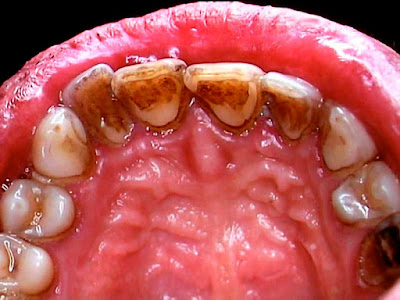 | |
| Cracked Tooth |
During an unexpected emergency dental visit, a patient may complain a tooth has pain when biting and this may suggest cracked tooth syndrome. They may not able to put any pressure on the tooth, and may avoid eating on that side.
A thorough visual examination with a digital x-ray would be required to determine the exact cause. A common cause of pain upon eating is a cracked tooth, but there are other possible causes to consider that are listed below.
COMMON CAUSES OF PAIN UPON BITING
- During biting, the ligament surrounding the tooth's root has been injured. This ligament is called the periodontal ligament (PDL)
- The tooth recently had a filling that was close to the tooth's nerve, and you are now trying to eat on that tooth
- The tooth recently had a root canal without a crown, and you are now trying to eat with that tooth
- The tooth had a root canal and filling/crown many months/years back, and now it's starting to hurt when biting down.
- The tooth has cracked and you are not able to place any pressure on that tooth
POSSIBLE SOLUTIONS TO ADDRESS PAIN UPON EATING
- If a tooth's ligament is injured, the typical scenario is to allow 3-4 weeks healing time to see if the ligament will repair itself. If the PDL ligament is still injured, the tooth may need to be evaluated for root canal treatment.
- If the tooth had a filling that was close to the nerve due to a deep cavity, it is recommended to allow 2-3 weeks to see if the nerve will "settle down." If the tooth still has pain upon afterwards, the tooth may need to be evaluated for root canal treatment.
- If the tooth recently had a root canal and you are having discomfort eating on the tooth, it is highly recommended a crown be placed on that tooth, especially if the tooth is a molar or premolar.
- If the tooth has an existing root canal and crown, and it's now starting to hurt when biting, there may be a deep internal root fracture. This tooth would need to be evaluated for possible root canal retreatment or extraction.
- If the tooth has cracked, it may exhibit cracked tooth syndrome.
WHAT IS CRACKED TOOTH SYNDROME?
Cracked tooth syndrome is the presence of an internal fracture inside the tooth. A piece of tooth may or may not "feel loose" though it may be sore to place biting pressure. The severity of the symptoms and treatment would be determined by the extent of the fracture if it is in the enamel or if it has extended to the dentin or pulp.A typical cause is due to excessive biting forces from inherent natural heavy eating forces, or from night time grinding (bruxism). A common symptom is you are not able to eat on that tooth, and this tooth would need to be evaluated for a porcelain crown and/or root canal treatment. If the fracture is too extensive, the tooth may need to be extracted.
If you have any questions about cracked tooth syndrome or what may be causing pain upon biting, be sure to consult your family dentist.
From the desk of your gentle family dentist in Bellevue,
Peter Chien, DMD, MPH
www.bellevuefamilydentistry.com
425-614-1600











